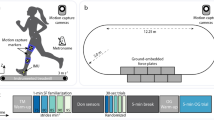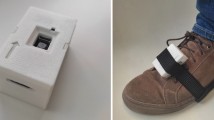Abstract
An inertial measurement unit (IMU) is widely considered to be an economical alternative to capture human motion in daily activities. Use of an IMU for clinical study, rehabilitation, and in the design of orthoses and prostheses has increased tremendously. However, its use in defining running gait is limited. This study presents a practical method to estimate running spatial and temporal parameters using an inertial sensor by placing it on a shoe. A combination of a zero-crossing method and thresholding is used to identify foot-strike and foot-off based on foot acceleration during running. Stride time, ground contact time and flight time can then be identified. An off-phase segmentation algorithm is applied to estimate stride length and running speed. These two parameters are commonly used to evaluate running efficiency and to differentiate elite runners. This study found that an IMU can estimate foot-strike and foot-off with average absolute time differences of 2.60–6.04 and 2.61–16.28 ms, respectively. Stride time was estimated with error between − 4.04 and 0.33 ms. Stride length and running speed were estimated with maximum average errors of 45.97 mm and 0.41 km/h.





Similar content being viewed by others
References
Gindre C, Lussiana T, Hebert-Losier K, Morin J (2015) Reliability and validity of Myotest for measuring running stride kenamtics. J Sports Sci. doi:10.1080/02640414.2015.1068436
Garcia Perez JA et al (2013) Effect of overground vs treadmill running on plantar pressure: influence of fatigue. Gait Posture 28:929–933
Nummela A, Keränen T, Mikkelsson LO (2007) Factors related to top running speed and economy. Int J Sports Med 28(8):655–661
Hreljac A, Stergiou N (2000) Phase determination during normal running using kinematic data. Med Biol Eng Compu 38:503–506
Fellin RE, Rose WC, Royer TD, Davis IS (2010) Comparison of methods for kinematic identification of foot-strike and toe-off during overground and treadmill walking. J Sci Med Sports 13:646–650
Osis ST, Hettinga BA, Leitch J, Ferber R (2014) Predicting timing of foot strike during running, independent of striking technique, using principal component analysis of joint angles. J Biomech 47:2786–2789
Yang S, Mohr C, Li Q (2011) Ambulatory running speed estimation using inertial sensor. Gait Posture 34(4):462–466
Bergamini E, Picerno P, Pillet H, Natta F, Thoreux P (2012) Estimation of temporal parameters during sprint running using a trunk mounted inertial measurement unit. J Biomech 45:1123–1126
Wixted AJ, Billing DC, James DA (2010) Validation of trunk mounted inertial sensors for analysing running biomechanics under field conditions, using synchronously collected foot contact data. Sports Eng 12(4):207–212
APDM, Inc. (2013) Motion Studio User’s Guide
Gouwanda D, Gopalai AA (2015) A robust real-time gait event detection using wireless gyroscope and its application on normal and altered gaits. Med Eng Phys 37(2):219–225
Chew D, Gouwanda D, Gopalai AA (2015) Investigating running gait using a shoe-integrated wireless inertial sensor. In: Proceedings of 2015 IEEE region 10 conference - TENCON 2015, 1-4 Nov 2015, Macao, China, pp 1–6
Leitch J, Stebbins J, Paolini G, Zavatsky AB (2011) Identifying gait events without a force plate during running: a comparison of methods. Gait Posture 33(1):130–132
Lee JB, Mellifont RB, Burkett BJ (2010) The use of a single inertial sensor to identify stride, step, and stance durations of running gait. J Sci Med Sport 13:270–273
Beato M, Bartolini D, Ghia G, Zamparo P (2016) Accuracy of a 10 Hz GPS Unit in Measuring Shuttle Velocity Performed at Different Speeds and Distances (5–20 M). J Hum Kinet 54(1):15–22
Li Q, Young M, Naing V, Donelan JM (2010) Walking speed estimation using a shank-mounted inertial measurement unit. J Biomech 43(8):1640–1643
Schache AG, Blanch PD, Rath DA, Wrigley TV, Starr R, Bennell KL (2001) A comparison of overground and treadmill running for measuring three-dimensional kinematics of the lumbo-pelvic-hip complex. Clin Biomech 16:667–680
Dixon SJ, Collop AC, Batt ME (2000) Surface effects on ground reaction forces and lower extremity kinematics during running. Med Sci Sports Exerc 32:1919–1926
Riley PO, Dicharry J, Franz J, Croce UD, Wilder RP, Kerrigan DC (2008) A kinematics and kinetic comparison of overground and treadmill running. Med Sci Sports Exerc 40(6):1093–1100
Author information
Authors and Affiliations
Corresponding author
Ethics declarations
Conflict of interest
The authors declare that they have no conflict of interest.
Rights and permissions
About this article
Cite this article
Chew, DK., Ngoh, K.JH., Gouwanda, D. et al. Estimating running spatial and temporal parameters using an inertial sensor. Sports Eng 21, 115–122 (2018). https://doi.org/10.1007/s12283-017-0255-9
Published:
Issue Date:
DOI: https://doi.org/10.1007/s12283-017-0255-9




